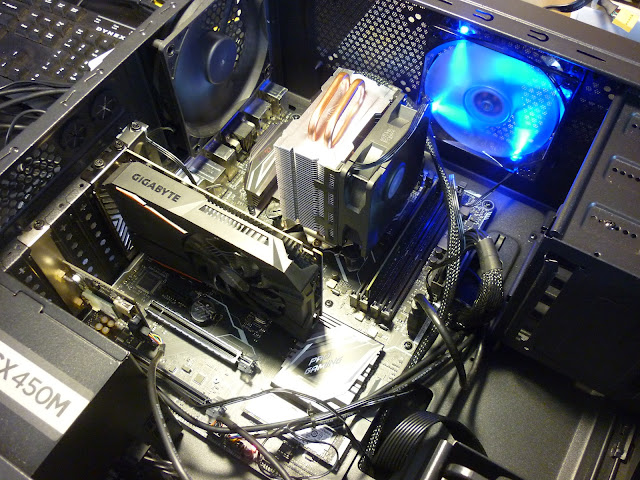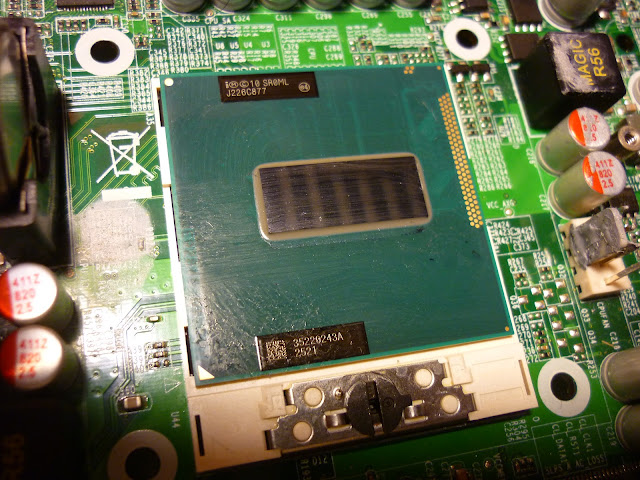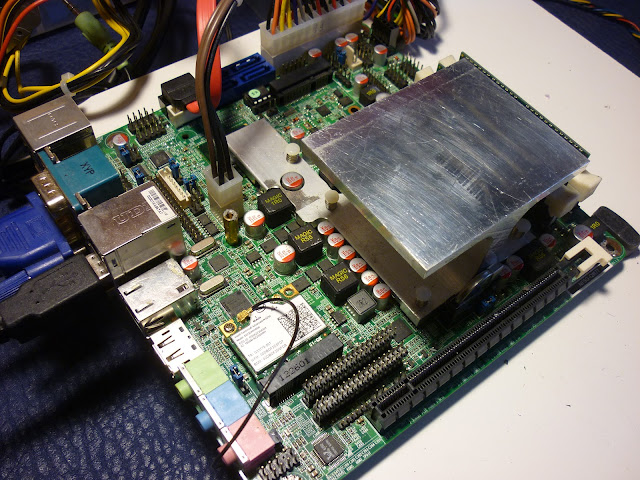Happy New Year!
The postman delivered the i5-3230M processor and I had something to keep me occupied to take the place of eating and drinking too much.
The old processor is an Intel Celeron 1020E, Ivy Bridge, released in Q1'13 and is quite a capable CPU despite what some would have you think about the Celeron name. I'm swapping the CPU because I can, not because I need to, it is merely a task to keep my numbskulls busy.
First order of business was to remove the motherboard from the case, then remove the aluminum heatsink that transmits heat from the socketed CPU and an embedded chipset processor. This is a tricky little operation as there are five spring loaded nylon pins, that can become brittle with time, they latch through the motherboard and hold the heatsink quite firmly, there is also a thin layer of thermal paste between both the processors and the lower surface of the heatsink.
If you look closely there are also five nylon spacers, one of which I nearly lost in the removal process, the devil is in the details when taking things apart. Usually, when I drop something small off my bench it is magically gone forever, however, I was lucky this time and found the spacer immediately.
The next photo is the Celeron 1020E still in the socket and the new brain patiently waiting by the side.
The Celeron on the left is a two core processor with two threads, the i5-3230M is two core, but has four threads. The new processor on the right is also Ivy Bridge, socket FCPG988 and it is rather interesting, yet boring, to research into all the differences of compatible processors for the G2 socket, Intel's Sandy Bridge, Ivy Bridge, suffice to say, it was a mobile processor socket, 1mm pitch, pin based array, so the processor, when oriented correctly, just drops into the socket.
When I say "just drops into" I mean it is "very carefully placed into" the socket.
Orientation is important, on the lower left corner of the processor there is marked a triangle, and if all the pins are straight, the package finds it's own way. The retaining screw is then rotated a little over a quarter of a turn. The final steps now are to put a dab of thermal paste of the shiny rectangle in the middle there, and on the embedded thingy and reinstall the heatsink.
I should look into what the embedded thingy is.
The motherboard is a Jetway NG9F-QM77 and the custom heatsink makes contact with the CPU and the Intel Mobile QM77 chip, both of which have a thermal cooling requirement, so both have a dab of thermal paste added and the heatsink is reinstalled.
The top of the heatsink will also be slathered with thermal paste and that will make contact with the small ITX case lid. The final step before reinstalling back into the case was booting up the computer to see if everything is ok, the BIOS takes one or three boots usually to work out what the heck has happened, so I usually experience a moment or two of blind panic during that process.
The BIOS settles itself down, the new processor is reported, the brain surgery is a success. The final step now is to reinstall the motherboard back into the case, apply more thermal paste to the top of the heatsink, install the cover and put all the screws back in if they are still in the same place on the bench and have not been lost in the process.
One last check is to run the operating system and see if everything appears fine. I was running it for several hours yesterday, CPU temperatures hovering around fifty degrees centigrade during high load which isn't bad at all, and the unit is completely silent, that ticks off my two boxes, low temperatures and low noise, or in this case, no noise. It must be ok as I have just completed this entire blog entry on the machine, we are back in business.
Once again, I wish you all a Happy New Year, hopefully this geezer will have more adventures in old tech in the next twelve months, if I do, they will be reported here.











